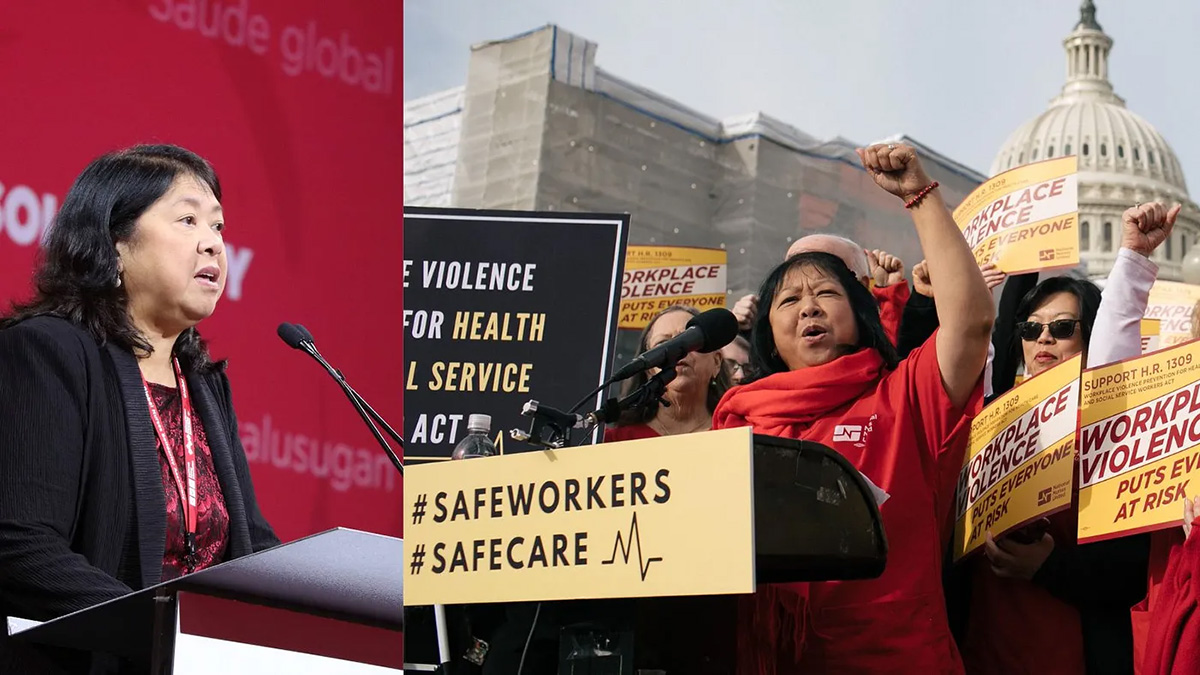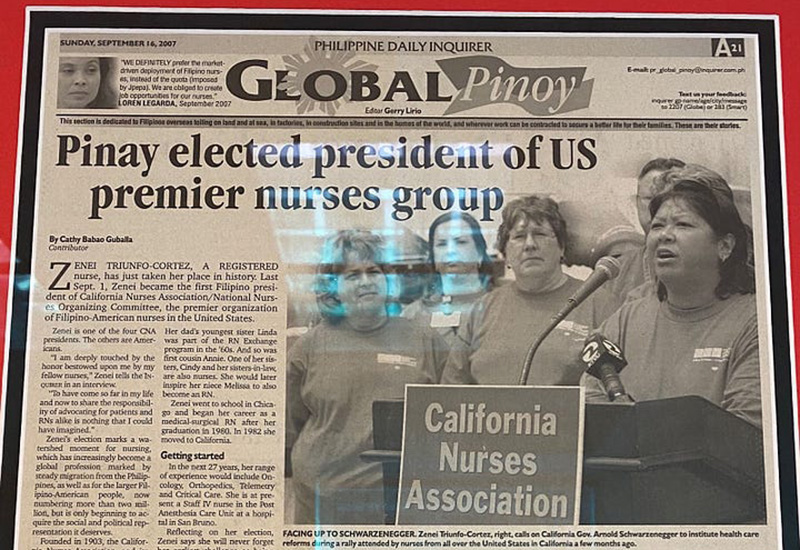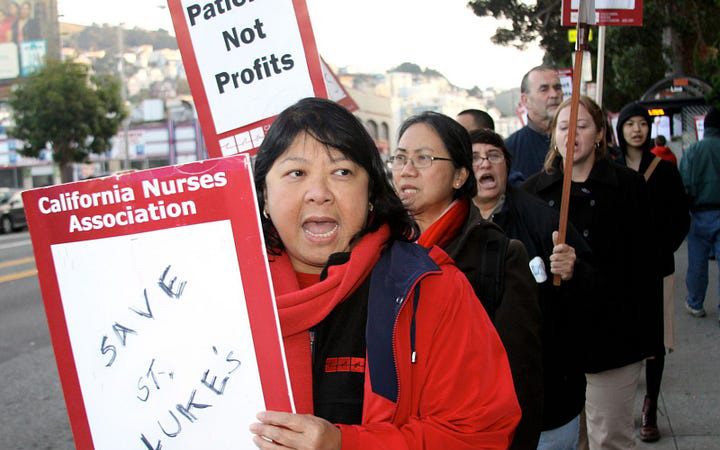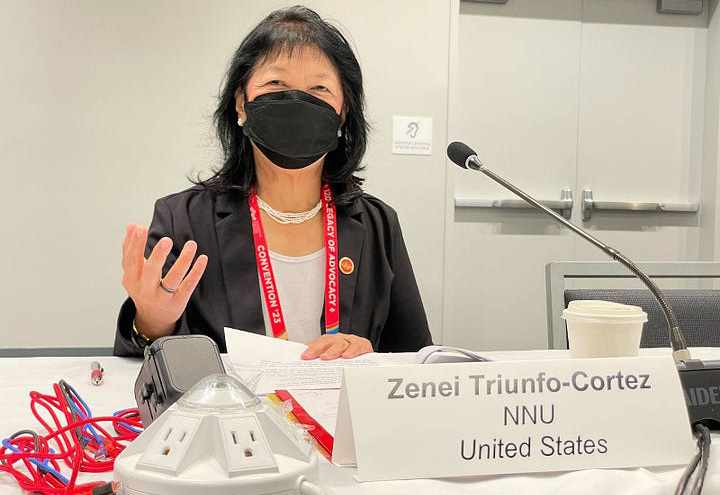Blog
Celebrating Filipinx nurses

Filipinx registered nurses are an essential part of the labor movement as rank-and-file union members and union leaders. They have been speaking up for their patients and nurses on the picket lines, at the bargaining table, in town halls, state legislatures, and in Congress. This October as we celebrate their achievements and contributions during Filipinx American History Month, we highlight Zenei Triunfo-Cortez, RN, a national nurse leader who has embodied the essence of union solidarity for decades.
Filipinx are the third largest Asian American Pacific Islander (AAPI) group in the country. As many people who work in health care know, Filipinx RNs have been an integral part of the nursing workforce in the United States for more than 100 years, particularly in California, where Filipinx nurses represent 18.4 percent of all RNs in the state. Moreover, Filipinx RNs make up 4 percent of all U.S. nurses, which is more than double the Filipinx percentage of the U.S. population. And they are a powerful presence in leadership positions at National Nurses United (NNU), the largest union of registered nurses in the country.
Representation matters, particularly at the top. Triunfo-Cortez’s trailblazing roles as the first Filipina president of NNU in 2018 and the first Filipina president of California Nurses Association/National Nurses Organizing Committee (CNA/NNOC) in 2007, have raised the visibility of Filipinx nurses in the labor movement and shown them and other AAPIs that they, too, can take leadership positions and confront structural racism in health care. In fact, her election to CNA/NNOC president was such a significant achievement that it made front-page headline news in the Philippines.

Union empowerment
A member of CNA since 1981, Triunfo-Cortez’s active union involvement began with a pivotal moment in her career. In 1990, a manager denied her application to transfer from the intensive care unit to the post-anesthesia care unit (PACU) at her hospital, Kaiser Permanente South San Francisco Medical Center.
“Not only was my transfer denied, but the manager said that ‘there were too many Filipinos working in PACU,’” recalled Triunfo-Cortez, who was utterly taken aback by the blatant discrimination. “I was so mad. I was qualified and as staff, I should have had priority. I wanted other nurses to know that this should not happen to anybody.”
Triunfo-Cortez decided to take on her employer and fight back. With the help of her union, she not only won and got the job, but succeeded in ousting that racist manager. After that empowering experience, she said, “I lost all fear because I asserted my rights and I felt the power of our union behind me.”
From that moment on, she got more involved with CNA, getting elected as a nurse representative and eventually taking positions with more responsibility: chief nurse representative, member of the bargaining team, chair of the professional practice committee (an elected, staff RN committee with representatives from every major nursing unit), board member, and a vice president.

Triunfo-Cortez also began serving as a lead member of the Kaiser Northern California bargaining team with Deborah Burger, RN, starting in 1998. “A few years later, when they bargained for a new contract, they really kept the team together,” said Cathy Kennedy, RN, and a member of CNA/NNOC’s Council of Presidents. “They won so many significant improvements, including the establishment of the quality liaison program, no cancellation of scheduled shifts, one wage grid for all of Northern California Kaiser facilities regardless of location, the reintroduction of the pension, and so much more.”
As a union leader, Triunfo-Cortez also engaged with nurses in different hospital systems in California and other states in organizing campaigns, informational pickets, and strike lines. For example, when St. Luke’s Hospital in San Francisco announced that it was closing in 2007, CNA nurses mobilized to keep it open. “Zenei really put a lot of time and effort into that initial fight to save St. Luke’s,” said Jane Sandoval, one of many Filipinx nurses who worked at the hospital at that time. “She picketed with us. She came with us on rounds to speak with San Francisco’s board of supervisors. We won that fight to keep St. Luke’s open.”
Sandoval also noted that Triunfo-Cortez stood by her side when Filipinx nurses filed a class action grievance in 2010, claiming that St. Luke’s was discriminating against hiring Filipinx RNs. “She supported us and made herself available,” said Sandoval who worked at St. Luke’s from 1985 until her retirement in 2021. “Zenei is the real deal — and she has a way about her that’s magnetic, kind, and powerful. Having her as a union leader lets people know that their voice matters.”

Filipinx nurses and the pandemic
Many Filipinx American nurses were on the front lines of the Covid-19 pandemic, risking their lives every day to care for their patients. Tragically, many lost their lives. According to NNU’s data, Filipinx RNs comprise 21 percent of all RN Covid deaths and a shocking 43.5 percent of the deaths of nurses of color (this statistic is based on the limited information compiled by NNU on the race and ethnicity of the nurses who died from Covid). This is an astounding number when you recall that Filipinx nurses comprise 4 percent of RNs in the United States. Yet they are a far higher percentage of nurses who died of Covid.
When the pandemic began, NNU was at the forefront fighting for nurses. Triunfo-Cortez along with other NNU leaders spoke up about the critical need for personal protective equipment for nurses and other health care workers, demanding stronger infectious disease guidance for the novel coronavirus, urging the federal Occupational Safety and Health Administration to issue an emergency temporary standard to protect health care workers, and sending petitions and letters to members of the U.S. Congress demanding the highest level of protections. Triunfo-Cortez and her colleagues participated in countless media interviews and virtual events, informing the public about the urgent need to protect nurses, patients, and other health care workers.
In 2020, Triunto-Cortez was recognized by U.S. News and World Report as a Hospital Hero and her union leadership and advocacy for nurses and patients was highlighted in an article in that publication. An article in Positively Filipino, also published that year, called her a “fierce fighter for fellow RNs” and “absolutely badass.” Earlier this year NurseJournal included her in their list of 16 AAPI nurses to know.

Union leadership
Despite her accomplishments, Triunfo-Cortez never expected to be elected as a union president and is very modest. “I am not an extraordinary person,” said Triunfo-Cortez. “I constantly tell other nurses, ‘You can do it, too.’”
Triunfo-Cortez has been a guiding light and mentor to countless nurses, including helping to organize RNs in Texas, Florida, Nevada, and California, including Kaiser Permanente Los Angeles Medical Center (LAMC), which has many Filipinx RNs. Cathy Kennedy, who worked on that successful organizing campaign with her, noted, “Zenei was larger than life there. The Filipinx nurses just surrounded her whenever they saw her and wanted to take pictures with her. It was great for them to see that she was one of the presidents of CNA.”
After 16 years as a CNA/NNOC president, Triunfo-Cortez stepped down from that position earlier this month but she carries on for another year as a president of NNU. She has great confidence in Michelle Gutierrez Vo, a Filipinx RN who was just elected to the CNA/NNOC Council of Presidents. “Michelle is a fearless and outspoken leader who will continue to fight for her patients and the rights of nurses,” said Triunfo-Cortez. “She will carry the torch of leadership and advocacy, making her own path and doing amazing things.”
“Zenei has inspired a lot of Filipina nurses and AAPI nurses to see that a Filipina nurse can take on such a big role,” said Gutierrez Vo. “Zenei’s work shattered walls and she is the epitome of fighting against a stereotype. She’s an immigrant and her leadership tells all the young Filipinx nurses out there that you have something to bring to the table.”